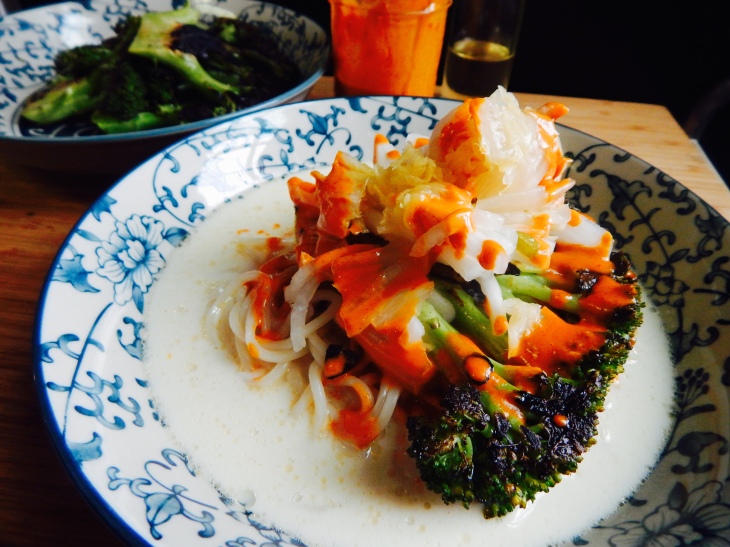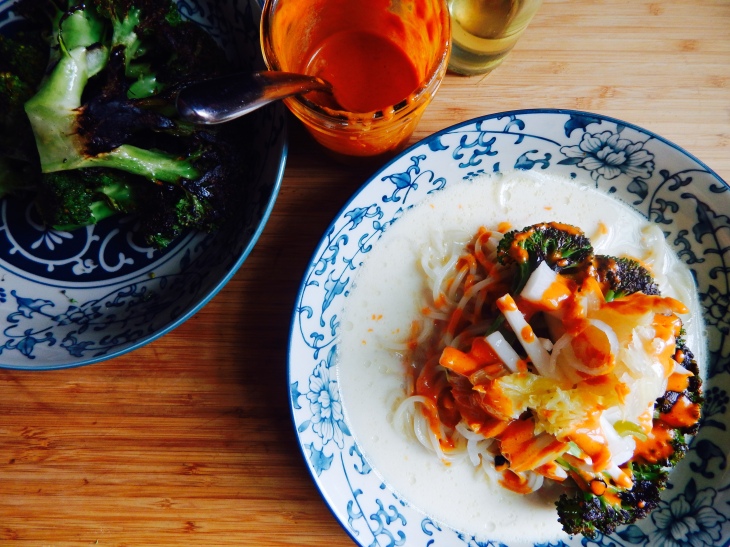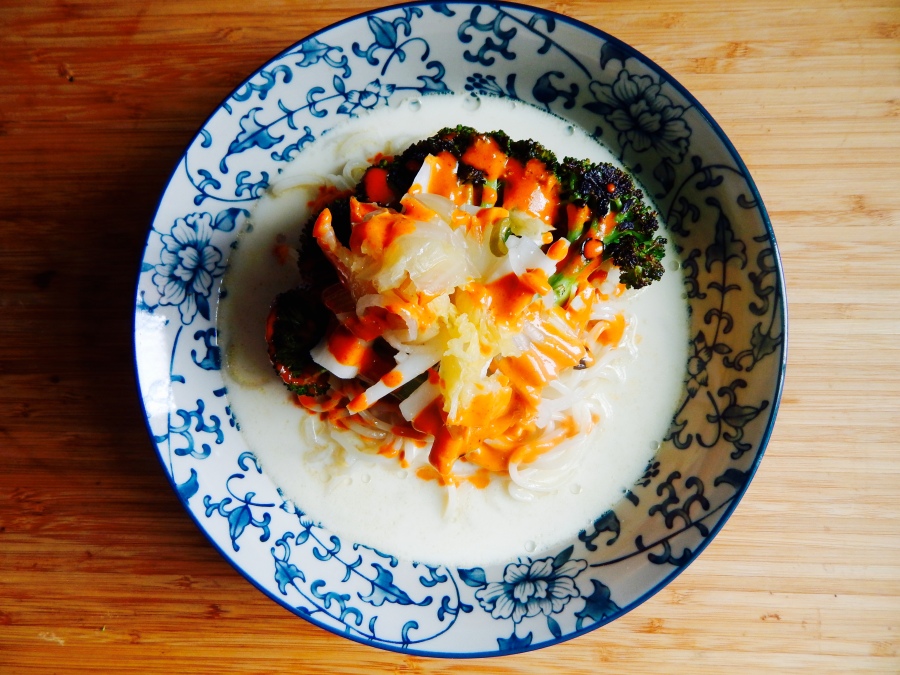I almost didn’t make this dish.
I had come across descriptions of this cold, soymilk-based soup when looking for information on Korean Buddhist culinary practices and thought it was pretty odd – maybe just odd enough for me to give it a shot. I had some dried soybeans deep in the cupboard from attempts earlier this year to make my own soymilk, so I soaked a cup and a half of them and put them in the fridge. I let a couple of days pass, leaving them in there, partly because I was too busy for a lunch-and-photo session and partly because I started thinking about cold noodles sitting in ice-cold soymilk, like some sort of soggy, stringy breakfast cereal.
But, as I had already gone and soaked the beans, I decided just to get it over with. And dang it if it isn’t some of the best cold-soup dishes I have ever had. I made the soymilk super rich with extra soybeans which, combined with the nuttiness from the sesame, made a solid foundation for sesame oil seasoned firm noodles. Seared broccoli and gochujang tahini sauce are just good no matter what they’re joined with, and vinegared daikon, white kimchi, and a dash of mustard oil add sharp tanginess that balance the richness of the broth.

Give it a shot, I’m glad I did. It does take a bit of time and muscle to strain and press the fresh soymilk, but I think it’s worth it as store-bought soymilk isn’t going to be nearly as rich. An added bonus is you can use the leftover soybean pulp, known as okara, in several dishes like this Japanese-style omelet. I’m sure roasted peanuts would also be good to use in place of the sesame seeds, and if I did that I might recommend trying peanut butter instead of tahini in the gochujang drizzle. Also, I used frozen Korean wheat noodles, but dried would do just fine. Or, as this dish is actually pretty inexpensive to put together, you could use spaghetti or even ramen to make it super frugal.

Konggoksu
Korean Cold Soymilk Noodle Soup
with Broccoli Steaks, Daikon, White Kimchi and Gochujang Tahini Drizzle
Serves 4 to 6
(adapted from maangchi)
Soymilk Broth:
1 1/3 c dried soybeans, rinsed and soaked overnight
1/2 c sesame seeds, toasted
salt, to taste
Broccoli Steak:
2 medium heads broccoli
oil
Daikon:
1/2 small daikon
1/4 c rice vinegar
1 tsp salt
Gochujang Tahini
1/4 c tahini
1/4 c gochujang
2 tbl to 1/4 c water
1 pound Korean wheat noodles (frozen or dried)
1 cup white kimchi
Mustard oil
TO MAKE THE BROTH:
– Drain the soaked soybeans and pour in a large bowl. Scrub them against the side of the bowl to loosen their skins.
– Rinse off the skins, put beans in a sauce pan, cover with an inch of water and bring to a boil over medium-high heat without a lid. Reduce heat slightly and boil gently for 45 minutes.
– Drain, rinse with cool water, and put into a blender. Add sesame seeds, 3 1/2 c water, and 1 tray ice cubes.
– Blend on highest speed for 45 seconds. Add a teaspoon of salt, blend to incorporate, and taste to correct the seasoning.
– Pass the mixture through a soymilk or nutmilk bag, a flour sack tea towel or several layers of cheesecloth. Press out the liquid, being careful not to bust the cloth and spray broth everywhere. Reserve the soybean pulp (okara) and refrigerate it if you like.
– Chill the soymilk while preparing the broccoli steaks.
TO SEAR THE BROCCOLI:
– Get your cast iron skillet smoking hot.
– Rinse the broccoli and pat dry.
– With a heavy, sharp knife, quarter each head vertically. Remove any broccoli florets that are too dangly and reserve for another use.
– Put 2 or 3 broccoli steaks in the smoking hot pan. Drizzle a little oil on each steak, then press them with something heat-resistant and heavy, like a 9-inch cake pan and your oven-mitted body weight. Sear for 3 minutes, flip, and sear again for 3 minutes.
– Repeat with remaining broccoli.
TO MARINATE THE DAIKON:
– Peel and trim the radish. Julienne, and toss with the vinegar and salt. Let sit 15 to 30 minutes, stirring occasionally.
TO PREPARE THE SAUCE:
– Mix together the tahini and the gochujang in a glass measuring cup or bowl. It will get very thick.
– Add water, little by little, while stirring continuously, until appropriate consistency is achieved. It should be a little thinner than ranch salad dressing. Chill until needed.
TO ASSEMBLE
– Prepare the wheat noodles according to the package directions. Rinse under cold water until completely cool, drain fully and toss with a little sesame oil.
– Place a mound of noodles in the middle of a large bowl or pasta plate. Ladle a cup or so of the chilled soy broth over the noodles.
– Place a broccoli steak on the noodles. Arrange some daikon on the broccoli, some kimchi on the daikon, and dash the mustard oil over the whole dish.
– Drizzle the tahini sauce over the whole thing. Sigsa mas-issgehaseyo!

